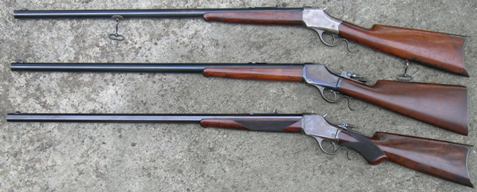March 6, 2011
 Offline
OfflineI have a set of wood, butt stock and forearm. It fits an 1892 perfectly, except for a thin gap along the top of the tang. It is a short forearm, but the forearm fits the 1892 perfectly. The butt stock has a Winchester plastic butt plate. Except for the thin gap along the top of the tang the butt stock fits correctly. What are the differences between the pre and post 64 wood types?
September 28, 2016
 Offline
OfflineThere are actually 3 variations of butt stocks. All 1894 94 1892 92 wood is interchangeable up until the 3rd variation model 94 which I believe was in 1948. From 48 to 64 these stocks are very close to the post 64’s but not exactly. The early stocks have small “wings” that come up along side the front portion of the upper tang. From 48 going forward the wings no longer exist. The lighter colored stock came from a 1953 model 94 and the dark colored one is from a 1906 vintage model 1894. Look closely at the very front of the wrist, you will see the Wings on the dark colored stock where as the the 53 vintage is milled flat across the same area. Also notice the front of the comb, how the older stock has a much sharper “point” compared to the later vintage.
Hope this helps.
Erin

April 15, 2005
 Offline
OfflineYou apparently have a mismatched stock set. If the butt stock correctly fits a Model 92 receiver frame, it is a pre-1948 stock. In early 1948 (January), Winchester altered the Model 94 receiver frame from a Type-2 to a Type-3 (I discussed this in the Model 94 Flat-band article). The forend stocks were changed (shortened) in early 1951 (again in January). Winchester did not make the change from the checkered steel butt plate to the plastic butt plates until 1964.
So, if you have a butt stock that fits a Model 92 receiver, it was intended for a pre-1948 Model 94, and it should have a steel butt plate. The forend stock was intended for a post-1950 Model 94.
Winchester used walnut to stock the standard Model 94 Carbines through 1980. That stated, the Model 94 Ranger (an economy variant) was stocked with Birchwood.
Bert
WACA Historian & Board of Director Member #6571L

April 15, 2005
 Offline
Offlinewolfbait said
Is there someone I can send some pictures to. thanks
WACA Historian & Board of Director Member #6571L

March 6, 2011
 Offline
OfflineI bought this 1906 32-20 carbine recently. Solid, properly functioning gun. When I got it home I discovered a very small bulge in the barrel 4″ from the muzzle. Now I can see it every time I look down the barrel. I can not live with that. I really can not sell it with a bulge in the barrel, so I guess I will part it out.
April 15, 2005
 Offline
OfflineWACA Historian & Board of Director Member #6571L

March 31, 2009
 Offline
Offlinewolfbait said
I bought this 1906 32-20 carbine recently. Solid, properly functioning gun. When I got it home I discovered a very small bulge in the barrel 4″ from the muzzle. Now I can see it every time I look down the barrel. I can not live with that. I really can not sell it with a bulge in the barrel, so I guess I will part it out.
This was caused by over pressure. Maybe some sort of obstruction in that area? Major corrosion can cause this. Shooting steel shot in the older shotguns can cause this too. Try to find another barrel.
June 11, 2014
 Offline
OfflineThe 32-20 is one of my favourite cartridges for small game. A shallow ring will still be safe to shoot but a visible bulge in the barrel is a horse of a different color. As far as accuracy goes, if it is only a shallow ring, I would shoot it at 50 yards. If you can still put five rounds into a 2″ circle at 50 yards, then it is still usable to take care of small game at relatively close ranges, such as Woodchucks and Racoons. However, lead bullets may produce leading in the last five inches of the bore since a lot of high pressure gas will blast by the bullet when it crosses the ring. With this in mind, you will likely be better off using jacketed bullets for your 32-20. A bulged barrel, however, should be replaced with another original barrel – if one is so fantastically fortunate to find one.


 Log In
Log In







